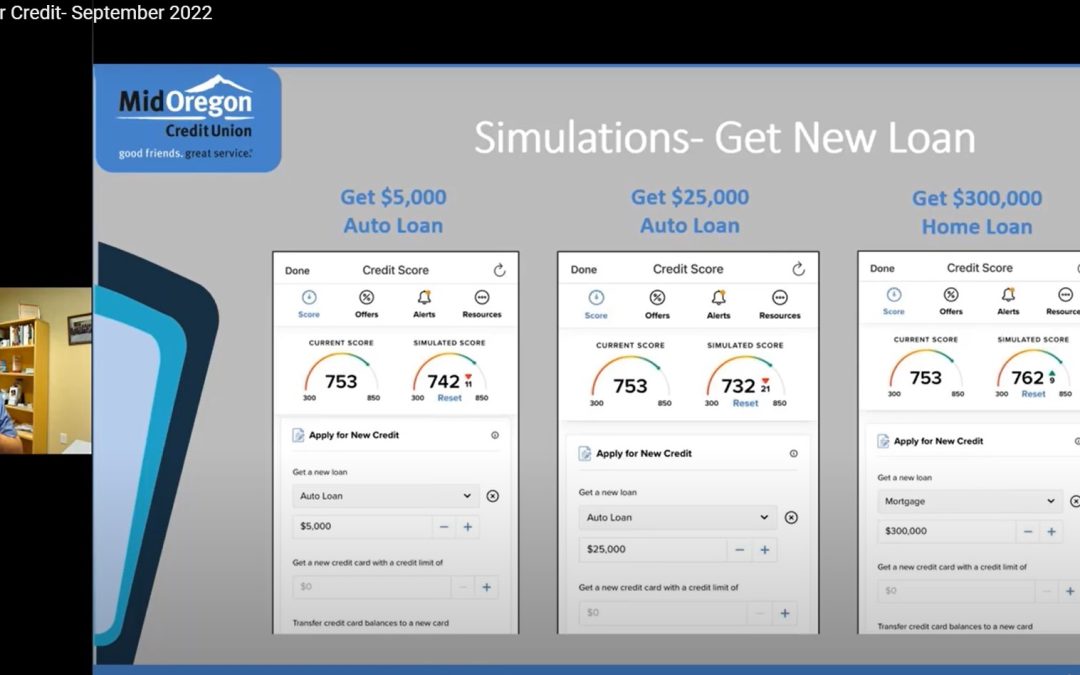The Bottom Line
Small business is important to Central Oregon, and to Mid Oregon. Find tips and resources for business, and information about Mid Oregon’s commercial services and business members.

Watch 2022 Financial Education Videos
Through October, Mid Oregon Credit Union has presented 17 Financial Fitness webinars on a variety of topics. All but one we have recorded, and they are available for viewing. One of our core purposes is to increase the financial literacy of our members, their families, and the community. As you can see below, you can easily watch 2022 financial education videos from anywhere, anytime.
Different Ways to Watch 2022 Financial Education Videos
Several of the presentations were done more than once during the year. While you can watch 2022 financial education videos from any of them, in this articles we’ve only included the most recent. To see all that are available, visit our YouTube channel, https://www.youtube.com/user/MidOregonCreditUnion. Your can also see the list from our website “Workshop Handouts and Archives” page.
Topic list:
2022 Financial Education Videos
Reaching Your 2022 Financial Goals, January 13, 2022
Presented by Wayne Hanson, Mid Oregon Credit Union. Are you determined to save for that upcoming trip, fund your emergency savings, or make the down payment on your dream car? Wayne will you show you the steps to set your “SMART goal,” determine funding sources, and see your goals become reality.
Video
Presentation Slide Deck
Goal-Setting Worksheet–One Year
NEFE-SMART Goal Setting
Goal-Setting Worksheet–Action Plan
Reaching Your Goals Resource List
Business Services: Reaching Your 2022 Business Financial Goals, January 27, 2022
Hear about business goal setting, honing in on financial type goals, and discuss how to achieve them. Learn about making meaningful financial goals and applying common financial tools and services to get in position to reach those goals. Join Wayne Hanson and Jacob Mayhill as they share principles and some real-world examples of what and how to do it.
Building a Basic Budget, February 10, 2022
Do you know where your last ATM withdrawal was spent? Are you living paycheck to paycheck? Do you have more month left at the end of your money? Watch our webinar to set your spending plan, in five steps. You will learn how to set realistic goals, track where your money goes, and develop that spending plan. Presented by Wayne Hanson, Community Development Officer, Mid Oregon Credit Union
Video
Presentation Deck
Handout: SMART Financial Goals
Handout: Cash-Flow Statement
Accessory Dwelling Units (ADUs): Are They Right For You? March 17, 2022
Accessory Dwelling Units, or ADUs and most people call them, are small homes built on the same property as a primary residence. In addition to increasing property value, ADUs can provide housing for elder family members, supplement income as a rental property, and much more. Join us on Thursday, March 17, 10 a.m., and learn more about ADUs, their many benefits, financing options, and determine if they are the right fit for your needs.
Business Services: “The Origin and Future of our Tight Labor Market”, with Damon Runberg, March 24, 2022
Presented by Damon Runberg, state economist with the Oregon Employment Department covering Central Oregon, the Klamath Basin, and the Columbia River Gorge. He writes prolifically and regularly gives presentations on the state of the local economy. The tight labor market we are experiencing has been the talk of the town for months. Most of these conversations lead to assumptions about “overly generous unemployment insurance,” “lazy workers,” or “greedy workers.” The labor market is in fact very tight, among the tightest markets on record, however the reasons why are far more complex than many of these assumptions. Damon will help put today’s labor market into perspective and look into the future to see whether we can expect hiring to become easier.
Take the Wheel, Get the Best Car Deal, March 24, 2022
Are you planning to buy a car? In today’s environment, is it more important then ever that when you find that vehicle, you make a good purchase decision. Find out how to save money and remain in control of your car deal. Learn how to determine how much car you can afford, deal with dealers, negotiate the best car price, benefit from buying used and figure out finance options.
Video
Presentation Slide Deck (.pdf)
Auto Buying Resources Handout
Vehicle Options Handout
Car Inspection Checklist Handout
Buyer’s Guide Example Handout
Preventing ID Theft (Handouts only. No video is available), April 28, 2022
FBI Fraud Alert Handout
Gift Card Scams Handout
How to Avoid a Scam (FTC) Handout
Identity Theft Recovery Plan (FTC) Handout
Identity Theft: What to Know, What to Do (FTC) Handout
Business Services: “Securing your future through Business Succession planning”, May 26, 2022
You’ve built your business into a valuable asset. Learn more about the essential steps to transition that value to secure your family’s future. Join Scott Reed, of Northwestern Mutual, as he shares how you can become the hero of your financial journey! . He has become inspired by the huge wave of employers who must monetize their business in the next few years to secure their future, because he is one of them!
Understanding Digital Banking, June 23, 2022
Presented by Jodie Rogers, Mid Oregon Credit Union. Get a guided tour through the main features of Mid Oregon’s new Digital Banking platform, such as the multiple ways to transfer funds, link outside accounts, personalize your security and alerts, and more. Plus, we’ll dig a little deeper to show you some features you might not expect!
Video
Presentation Slide Deck (.pdf)
Parenting in a Digital World, September 15, 2022
Presented by guest speaker, Ryan Comingdeer, technology and parenting evangelist (and parent of five girls). This workshop will address how parents can keep their kids safe in the digital world. We will review how to discuss online security with your child, the best practices to implement security, tools to lock down your environment and how to best monitor your household activity. You will leave with an understanding of next steps and how to protect your family from spiritual, physical and emotional attacks.
Video
Presentation Slide Deck (.pdf)
Managing Your Credit, September 20, 2022
The last couple of years have been difficult, and it may be a good idea to evaluate where you are financially. In our Managing Your Credit webinar, learn what factors affect your credit score, how to build a good credit history, the differences and connections between your credit report and credit score, and ideas for improvement.
Video
Presentation Slide Deck (.pdf)
Credit Report FAQ Handout
Credit Score FAQ Handout
Vantage Credit Score Handout
Estate Planning Essentials, October 13, 2022
Special Guest Presenter Jeff Patterson of Lynch Murphy McLane LLP will cover wills, trusts, powers of attorney, healthcare documents, and beneficiary designation assets/accounts. He’ll also cover questions about what happens when someone becomes disabled/incapacitated and how the Oregon and federal estate tax laws can affect one’s estate and estate-planning considerations.
Video
Presentation Slide Deck (.pdf)
Understanding the ABCs (and Ds) of Medicare, October 20, 2022
Presented by Emily Carrick, with PacificSource Medicare. Learn more about who is eligible for Medicare, and answer your most frequently-asked questions, including: When to sign up for Medicare, and how to do it; what is covered, and not generally covered by Medicare; what the differences are between a Medicare Supplement plan and a Medicare Advantage plan; extra help for people with limited income and resources; and where to go for expert help with your Medicare decisions.
Video
Presentation Slide Deck (.pdf)
Medicare Beginner’s Guide (.pdf)
Future Live Webinars and Workshops
We have two more webinars scheduled for 2022: Building a Basic Budget on 11/15 at 7 p.m., and Preventing ID Theft on 12/8 at 10 a.m. Preventing ID Theft will not be recorded, so joining the webinar live is your option. Check our Financial Workshops page to learn more about these, and future webinars and live workshops.

Tips to Manage Your Holiday Spending
The holiday season is upon us, bringing images of gatherings with friends and family, pumpkin pie, decorated trees, gifts—and debt? Avoid owing more money by learning to better manage your holiday spending.
It can be easy to go overboard on holiday shopping, but with a little bit of planning and budgeting, it is possible to celebrate without spending a fortune. Here are some tips:
7 Tips to Manage Your Holiday Spending
Give yourself a set amount to spend. Your budget is your buddy if you want to keep holiday spending under control. Determine how much to spend and give yourself a hard limit to ensure you stay under budget. Track your expenses so you know what
you’re spending and can stay on track.
Set budgets for everyone on your shopping list. From your nearest and dearest to your thoughtful neighbor, provide a dollar figure for each person you are gifting. Setting individual spending amounts can help pace your purchases.
Remember Non-Gift Spending, Too
Make sure your budget covers all holiday expenses—not just gifts. Gift-buying is a major expense in any holiday shopping budget, but shouldn’t be the only expense you consider. Planning to buy any new holiday decorations or hosting a holiday dinner? What about traveling? Manage your holiday spending to ensure your budget covers all expenses.
Shop early to hunt for deals. When it comes to holiday deal-hunting, the early bird may still get the worm. Pay attention to ads and promotions such as Black Friday and Cyber Monday, and see if you can get more bang for your buck.
Focus on crafts, homemade gifts or experiences. Consider alternative types of gifts that are easier on your budget and often more meaningful. You can make a homemade candle or wreath, bake a holiday dish or offer to clean a loved one’s home. These can be more appreciated and memorable than a store-bought gift.
Begin at the Beginning of the Year
Save year-round. The costs of holiday spending can be overwhelming for a one- or two-month budget. Save yourself this financial burden by setting aside monthly savings to spend throughout the holidays. It may be too late to take advantage of this budgeting tip for the coming holiday season so make a plan for 2023, such as a Savers Club account.
Skip a Payment. Free up your cash by taking advantage of this Mid Oregon service and enjoy a little breathing room during the holiday season. If you don’t have your loans with Mid Oregon, ask your financial institution what they can do.
It is worth it to manage your holiday spending and avoid the credit card debt hangover. Even if you can avoid the extra debt, you might have to sacrifice in other ways. Whether you struggle with holiday spending or you’re just looking for ways to better manage your money, using these budgeting tips can help you become a smarter shopper and spare you the stress of overspending.
Cheers!

Effectively Manage your Credit Card Debt
What does credit card management mean?
Credit card management is an important skill to develop to ensure your long-term financial health. Having smart strategies for spending, making payments on time, monitoring usage, and more might seem daunting, but can have a big impact on your credit score—and stress level.
Studies have shown that most American adults have at least one (or more) credit cards. Many of the things we love about them—convenience, safety, tracking, rewards—are the same qualities that can tempt us into overuse.
We then find ourselves at the end of the billing cycle and confronted by our credit card debt, as well as the interest rate associated with any carryover balances. These unpaid balances can accumulate over time and seem impossible to get under control.
Save time, money and headaches down the road by remembering these simple tips.
Why Is Credit Card Management Important?
Credit cards are a helpful tool for many different situations, whether that’s financing a large purchase or just online shopping. However, it’s also critical that credit card users actively manage their open accounts. Poorly managed credit cards can lead to bad financial outcomes, like credit card debt and dings on your credit score. If you have a habit of badly managing your credit card, it can make it much harder to get new credit cards in the future, as well as other types of loans.
Tips for How to Manage a Credit Card
There’s no doubt that managing your credit card is important. But you might not know what the most important steps are. Here are a few tips that you can follow to keep yourself on track and responsible, no matter what you use your credit card to purchase.
- Always pay by the due date. Credit cards charge interest. That means if you don’t pay off your full balance, the remaining amount will increase at a certain rate (that’s your interest rate). Paying off your full balance, not just the minimum, is the only way to avoid paying interest.
- Read the Terms and Conditions. When you get your credit card, it will come with documentation outlining the terms and conditions of your account. Are you being charged an annual fee? what is your annual percentage rate? What is your credit limit? When is your payment date, and is there a grace period? While you don’t have to read the small print in one sitting, it’s crucial to go over it as soon as you get the card in your hands. Break it down by section so you know exactly what you have access to and what your credit card company expects.
- Practice responsible spending. Will you only use this card in an emergency? Expenses for travel? What about auto repairs? Shopping excursions for groceries? Gas fill-ups? Before you start using it on a daily basis, figure out what your own boundaries are. It’s possible to wing it, but you don’t want to start doing so without any guidelines or personal boundaries. Begin with increasing modest expenditures such as gas or groceries while familiarizing yourself with how everything works. You want to make minor purchases that you can pay off quickly before each payment cycle ends.
- Monitor your activity. Take the time to examine your credit card bills and charges. Not only are you ensuring that each transaction is legitimate, but it also allows you to see precisely where and how your card is being used. If something doesn’t appear to be correct, call your lender right away to get it corrected.
- Manage debt responsibility. Using a credit card is basically taking a short-term loan each time you use a credit card. The loan’s terms state that it must be repaid at the end of each month. When you don’t pay off your credit card bill each month, debt builds up. Even if you make the smallest payment—usually a fraction of the total amount, such as $25 or $50—interest will begin to build on the remaining balance. Credit card debt may have a serious impact on your finances over time. If you find yourself with mounting credit card debt, it’s critical that you have a plan for dealing with it.
- Shop around before applying. You are wise to shop around for the best sustainable rate on a credit card or loan and work with a trusted provider. Mid Oregon Credit Union offers a variety of options. Check out our rates and apply online or call today at 541-382-1795.
Credit card management is essential to financial health. Credit cards make modern living quick, efficient, and easy—plus many credit cards come with perks and rewards. However, reaping those benefits requires you to always keep a careful eye on the way that you use your credit cards.
